Video Cameras
NAB Day 1 - AJA CION
April/07/14 17:07
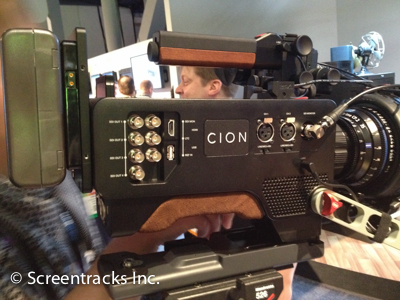
Great minds think alike - AJA comes out with their 4k, PL-mount CION (pronounced scion) as in “scion of an old family”.
With a 4k APS-C sized CMOS global shutter sensor recording full 4k or UHD at 60p, as well as hardware-scaled 2k and 1080, to AJA’s SSD Pak storage units. These are available in 256GB or 512GB sizes, and as such the cost per GB will be considerably less, methinks, than the BM URSA. It is also more shoulder-friendly than the URSA, as it is about half the weight and size, and has a nice cushy leather pad built in.
It may be lighter, smaller and have less expensive media than the URSA, but it is slated to cost about 50% more - $9,000.
One of the nice features is a mechanical back focus adjustment which is accessed via a panel on top.
Comments
NAB Day 1 - Blackmagic URSA
April/07/14 16:40
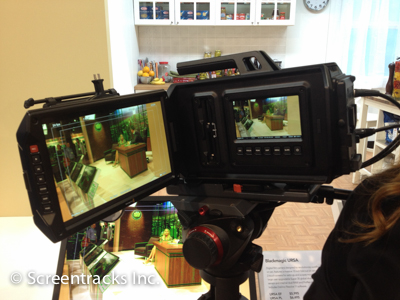
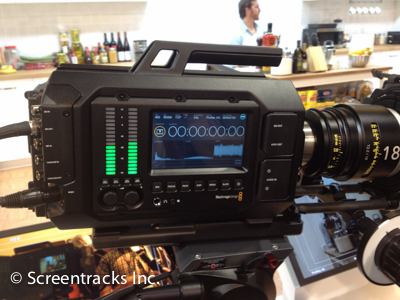
Happened to walk right in the door by Blackmagic after reading Grant Petty’s email announcement of this year’s slew of schtuff. The green tints on the monitors in the first image is due to focus enhancement being on.
The URSA is a large, 15-lb. upgradeable body that comes in several lens mount flavors, sports a Super 35 global shutter 4k imager, a 10” side screen on the left side, and a 5” screen on the right side for setting, status and scopes. It will record Cinema DNG RAW and ProRes 4k to two CFast card slots, currently a spendy proposition, with cards like SanDisk’s 120GB CFast 2.0, which currently go for about $1,200 each. And 120GB doesn’t get you a whole lot of time at RAW or ProRes 4k rates.
It ships 4k 60p capable, but will be upgradeable to 120fps. The imager will be upgradeable as well. The first two units, the URSA EF and URSA PL (referring to their lens mount types) are slated to show “around July” for $5,995 and $6,495 respectively.
Last DSLR Joke (maybe)
March/25/14 10:40
Well, I was going to stop ridiculing DSLRs as video cameras, because I figure that's just about over - (the ability, in good conscience, to give them crap) since any day now DSLRs should fully morph into ‘real’ video cameras.
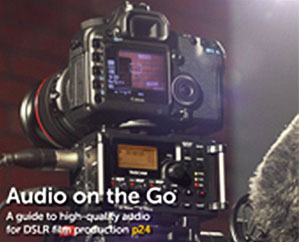
But then I open my e-mail this morning and I see this picture on the cover of Audiomedia. This is the kind of thing that kills me. DSLRs are so awesome!* But if you want to record decent quality video, you need an external recorder. And if you want to record decent quality audio, you need an external recorder. And if you want all this stuff to function together as a unit, you need some sort of rig.
Now admittedly, I'm going around with an Atomos Samurai hanging off of my camera rails, which has extended the life of my EX-1, so in a sense I don't have a leg to stand on. But I'm a big believer in fully functional camcorders, particularly in the real world of live and corporate and running gun.
I remember the days when ‘tape operator’ was a separate job because the recorder was so heavy it required a second person to carry and operate it. But for a long time now you have been able to get cameras with good optics, good codecs, a fully functional zoom lens, and reasonable ergonomics at a reasonable price. Heck, some of those BetaCam rigs used to cost more than a luxury car.
So this return to separate imaging devices with external video and audio recording devices cracks me up. I suppose if you are shooting Cine-style, it harkens back to shooting film with audio recording on a Nagra. But I mean seriously, that's as if you had a film camera, but had to have a separate film recorder external to the camera!
Don't get me wrong, I'm actually excited about where all this is headed. I love this point in a technology, where you see something new evolving, and you are not entirely sure what it is going to become.
So let me have my last 10 minutes of fun.
*Don't give me a hard time about this joking statement. I know, they are actually awesome.

But then I open my e-mail this morning and I see this picture on the cover of Audiomedia. This is the kind of thing that kills me. DSLRs are so awesome!* But if you want to record decent quality video, you need an external recorder. And if you want to record decent quality audio, you need an external recorder. And if you want all this stuff to function together as a unit, you need some sort of rig.
Now admittedly, I'm going around with an Atomos Samurai hanging off of my camera rails, which has extended the life of my EX-1, so in a sense I don't have a leg to stand on. But I'm a big believer in fully functional camcorders, particularly in the real world of live and corporate and running gun.
I remember the days when ‘tape operator’ was a separate job because the recorder was so heavy it required a second person to carry and operate it. But for a long time now you have been able to get cameras with good optics, good codecs, a fully functional zoom lens, and reasonable ergonomics at a reasonable price. Heck, some of those BetaCam rigs used to cost more than a luxury car.
So this return to separate imaging devices with external video and audio recording devices cracks me up. I suppose if you are shooting Cine-style, it harkens back to shooting film with audio recording on a Nagra. But I mean seriously, that's as if you had a film camera, but had to have a separate film recorder external to the camera!
Don't get me wrong, I'm actually excited about where all this is headed. I love this point in a technology, where you see something new evolving, and you are not entirely sure what it is going to become.
So let me have my last 10 minutes of fun.
*Don't give me a hard time about this joking statement. I know, they are actually awesome.
Canon 1DC and Panasonic GH4 - They're Almost Video Cameras!
March/06/14 11:20
The thing that's killing me about this new crop of cameras is that we are getting to the point where a given DSLRs’ video performance is exceeding its still picture performance.
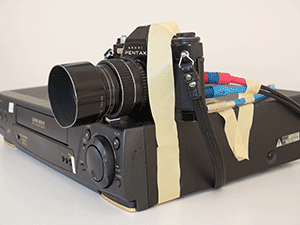
Yep - this is my new Pentaxasonic VHS DSLR. Both the rig and the footage from it have a nice “retro high end” look. It rests on the shoulder pretty well, and grabbing the far side makes for a stable platform. This weekend though, I think I’ll take the feet off the VCR and screw the butterfly handlebars from my Schwinn upside-down into the bottom. It’ll be retro-bitchin’. The drawback to this rig is that you do need a really long extension cord for powering the VCR. I have a team working on a car battery adaptor and tray for it that fits underneath – balances the rig out pretty well.
I thought I would get this product out there on the market before sub-$10k DSLRs really do turn into video cameras. Wouldn’t be surprised if there’s one or two at NAB 2014 next month. Of course, I’ve been expecting that for a while now.
I admit sometimes I can’t figure out why “the DSLR revolution” irks me so much. I guess I come from the olden times when cameras were cameras, and you knew what was still and what moved, and the twain did not meet.
Used to be that video-capable DSLRs were always very good still cameras, so you could forgive some of the video shortcomings - but now some reports and imagery from the 1DC and GH4 suggest they are somewhat underwhelming as still cameras at their given price points. The ironic thing is that they are still lacking major functionality features of video cameras. So still not quite fish or fowl.
I get the appeal of DSLRs - they can take big, fat, high-resolution, big pixel images with easily limited depth of field, yielding a filmic look. If you own lenses that fit on them, you’re half kitted out already. If you are a still photographer, you can move into videography with minimal investment.
Yet most have been hobbled by crap codecs - a bit like recording a very nice lens and sensor to VHS tape - as well as functionality limits which, if missing from a pro camcorder, would get you laughed out of the room (and no sales). You need to spend an average of one to two times the cost of most DSLRs on ancillary gear to make it simulate a pro video camera’s functionality.
The GH4 is taking the step of offering some of that functionality in a $2k add-on box. So you’re at around $3,700 for something approaching a video camera. And the 1DC? $10k for the body alone. You can get some nice camcorders with a fully functional zoom lens for that.
Yet they continue to grow in popularity. I’ve noticed more and more recent online freelance job solicitations specifying the desire for DSLRs and DSLR experience. Do you want to place any bets on how many of those client-side folk have any idea why they are asking for it? (Bob in accounting has one.) And none of those same folks were specifying the type of HD camera they wanted prior to the DSLR revolution.
But you know what? It doesn’t matter! Never really has. It’s not about the gear. It’s what you point it at. Not that we’re going to stop talking about the gear…

Yep - this is my new Pentaxasonic VHS DSLR. Both the rig and the footage from it have a nice “retro high end” look. It rests on the shoulder pretty well, and grabbing the far side makes for a stable platform. This weekend though, I think I’ll take the feet off the VCR and screw the butterfly handlebars from my Schwinn upside-down into the bottom. It’ll be retro-bitchin’. The drawback to this rig is that you do need a really long extension cord for powering the VCR. I have a team working on a car battery adaptor and tray for it that fits underneath – balances the rig out pretty well.
I thought I would get this product out there on the market before sub-$10k DSLRs really do turn into video cameras. Wouldn’t be surprised if there’s one or two at NAB 2014 next month. Of course, I’ve been expecting that for a while now.
I admit sometimes I can’t figure out why “the DSLR revolution” irks me so much. I guess I come from the olden times when cameras were cameras, and you knew what was still and what moved, and the twain did not meet.
Used to be that video-capable DSLRs were always very good still cameras, so you could forgive some of the video shortcomings - but now some reports and imagery from the 1DC and GH4 suggest they are somewhat underwhelming as still cameras at their given price points. The ironic thing is that they are still lacking major functionality features of video cameras. So still not quite fish or fowl.
I get the appeal of DSLRs - they can take big, fat, high-resolution, big pixel images with easily limited depth of field, yielding a filmic look. If you own lenses that fit on them, you’re half kitted out already. If you are a still photographer, you can move into videography with minimal investment.
Yet most have been hobbled by crap codecs - a bit like recording a very nice lens and sensor to VHS tape - as well as functionality limits which, if missing from a pro camcorder, would get you laughed out of the room (and no sales). You need to spend an average of one to two times the cost of most DSLRs on ancillary gear to make it simulate a pro video camera’s functionality.
The GH4 is taking the step of offering some of that functionality in a $2k add-on box. So you’re at around $3,700 for something approaching a video camera. And the 1DC? $10k for the body alone. You can get some nice camcorders with a fully functional zoom lens for that.
Yet they continue to grow in popularity. I’ve noticed more and more recent online freelance job solicitations specifying the desire for DSLRs and DSLR experience. Do you want to place any bets on how many of those client-side folk have any idea why they are asking for it? (Bob in accounting has one.) And none of those same folks were specifying the type of HD camera they wanted prior to the DSLR revolution.
But you know what? It doesn’t matter! Never really has. It’s not about the gear. It’s what you point it at. Not that we’re going to stop talking about the gear…
4K Camera News
September/24/13 12:08
The new Sony 4k PXW-Z100 and FDR-AX1 4k cameras
Here's a clip from Alister Chapman at IBC about the new Sony 4k PXW-Z100 camera - and at about 2:30 they talk about why you would use the PMW-200 over this jobber!
http://www.newsshooter.com/2013/09/13/ibc-2013-sony-pxw-z100-and-fdr-ax1-4k-cameras/
So don't feel so bad! You probably have a better camera! Unless you have client clamoring for 4k…..
But seriously, 4k on a less-than-half -inch chip!? I notice all the demo shots are wide, because if they shot close you would see how video-y it will look. Still, pretty cool.
What I have been imagining is a camera like the EX3 with (3) 4k chips, or one big one. Been looking again at the FS-700, as they have enabled the 4K capability on that, and it looks pretty. Super 35mm sensor as in the F5 and F55.
A quick way to explain the Bayer sensor deal (almost all of these large single-chip cameras nowadays are Bayer sensors) is:
"One thing to remember is that because of the nature of a Bayer sensor you need the sensor to have a higher pixel count than the final desired resolution. Typically you want at least 30% more pixels than your target resolution. As a minimum for good 1080 you want around 2.5K-2.7K pixels."
That's also from Alister Chapman, a cameraman/blogger who knows his stuff. So when the REDs of the world are bragging on their latest mega-mega-pixel sensor, you have to ask, "how many REAL pixels is that?"
Here's a clip from Alister Chapman at IBC about the new Sony 4k PXW-Z100 camera - and at about 2:30 they talk about why you would use the PMW-200 over this jobber!
http://www.newsshooter.com/2013/09/13/ibc-2013-sony-pxw-z100-and-fdr-ax1-4k-cameras/
So don't feel so bad! You probably have a better camera! Unless you have client clamoring for 4k…..
But seriously, 4k on a less-than-half -inch chip!? I notice all the demo shots are wide, because if they shot close you would see how video-y it will look. Still, pretty cool.
What I have been imagining is a camera like the EX3 with (3) 4k chips, or one big one. Been looking again at the FS-700, as they have enabled the 4K capability on that, and it looks pretty. Super 35mm sensor as in the F5 and F55.
A quick way to explain the Bayer sensor deal (almost all of these large single-chip cameras nowadays are Bayer sensors) is:
"One thing to remember is that because of the nature of a Bayer sensor you need the sensor to have a higher pixel count than the final desired resolution. Typically you want at least 30% more pixels than your target resolution. As a minimum for good 1080 you want around 2.5K-2.7K pixels."
That's also from Alister Chapman, a cameraman/blogger who knows his stuff. So when the REDs of the world are bragging on their latest mega-mega-pixel sensor, you have to ask, "how many REAL pixels is that?"
Arri Amira - We Don' Need No Stinking 4K!
September/19/13 12:02
Yeah - no way I could afford it either - but it's pretty!
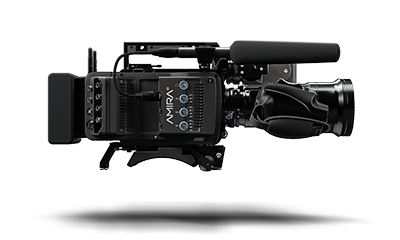
http://www.arri.com/amira/
The major thing is THEY BUILT A CAMERA THAT YOU CAN PICK UP AND SHOOT WITH like normal cams of yore! Did you see the adjustable shoulder rest and eyepiece?! Don't need an effing cage with crap bolted all over it! AND FULL QUALITY 200fps! Yowza indeed.
They have some over-the-top grading on the showreel stuff, but I generally like the look of Alexa-stuff over RED. Haven't ever really cared for the look of a lot RED footage - it seems to have a “hardness” that doesn’t appeal to me. Still like the look of Sony stuff though - guess I'm a traditionalist. They get slammed a lot for being excessively red-tinted by people who like the green-leaning look of Ikegami (if they're old like some of us) or the "moody" green grades you see in movies these days.
Still hope to one day either be able to afford (have jobs for) an F3, or maybe an FS-700. I keep thinking (thought the new EX-3 upgrade, the PMW-300 was going to be it - but it ain't) they're going to combine an EX-style camera with an F3-type sensor and such.
Good article on trying to make sense of sensor size and crop factor:
http://www.lensrentals.com/blog/2012/01/sensor-size-matters-part-1
It's skewed toward still cameras a bit, but overlaps video a fair amount. Haven't read the whole thing (makes my head hurt), but so far he's left out the whole 3-chip vs. 1-chip deal, which a lot of talk about sensor size tends to do. Read up on "de-Bayering" - what 1 chip large sensor cameras have to do to make 3 colors. You have to get up into the F5 kind of money, I believe, before you get into a camera that doesn't have to do a bunch of computational magic to simulate 3 colors (unlike traditional 3-chip cameras). But most people don't care or know about that. Big sensors do have a number of benefits that outweigh the negatives - particularly for people that don't ever have to deal with the technical issues!
The other big thing about most of these cameras is that you are typically looking at an investment of 1-2 times the cost of the camera body to fit it out with lens(es) and ancillary gear needed to make it function like a normal, full-on camcorder. Hence you have all these still photographers that led the charge into DSLR video, since they already had a significant investment in camera lenses.
Even with the Blackmagic Pocket Cinema Camera (around $1k), you kinda want a good all-around lens with Image Stabilization, etc. which is going to run you more than $1k -- then you need a boatload of spare batteries (they only last ½ hour) and high-end memory cards, blah blah. And it's only "Super 16" size (smaller than full 16).
Speaking of the BMPCC - this is a kinda nice piece shot on it, from Philip Bloom - though largely due to the light and the subject. If you were standing next to him with your camera (what ever it may be), you would have gotten some really nice footage as well.
https://vimeo.com/72996911
He did a lot of post on it with FilmConvert, etc.
http://philipbloom.net/2013/08/27/pocketcamera/

http://www.arri.com/amira/
The major thing is THEY BUILT A CAMERA THAT YOU CAN PICK UP AND SHOOT WITH like normal cams of yore! Did you see the adjustable shoulder rest and eyepiece?! Don't need an effing cage with crap bolted all over it! AND FULL QUALITY 200fps! Yowza indeed.
They have some over-the-top grading on the showreel stuff, but I generally like the look of Alexa-stuff over RED. Haven't ever really cared for the look of a lot RED footage - it seems to have a “hardness” that doesn’t appeal to me. Still like the look of Sony stuff though - guess I'm a traditionalist. They get slammed a lot for being excessively red-tinted by people who like the green-leaning look of Ikegami (if they're old like some of us) or the "moody" green grades you see in movies these days.
Still hope to one day either be able to afford (have jobs for) an F3, or maybe an FS-700. I keep thinking (thought the new EX-3 upgrade, the PMW-300 was going to be it - but it ain't) they're going to combine an EX-style camera with an F3-type sensor and such.
Good article on trying to make sense of sensor size and crop factor:
http://www.lensrentals.com/blog/2012/01/sensor-size-matters-part-1
It's skewed toward still cameras a bit, but overlaps video a fair amount. Haven't read the whole thing (makes my head hurt), but so far he's left out the whole 3-chip vs. 1-chip deal, which a lot of talk about sensor size tends to do. Read up on "de-Bayering" - what 1 chip large sensor cameras have to do to make 3 colors. You have to get up into the F5 kind of money, I believe, before you get into a camera that doesn't have to do a bunch of computational magic to simulate 3 colors (unlike traditional 3-chip cameras). But most people don't care or know about that. Big sensors do have a number of benefits that outweigh the negatives - particularly for people that don't ever have to deal with the technical issues!
The other big thing about most of these cameras is that you are typically looking at an investment of 1-2 times the cost of the camera body to fit it out with lens(es) and ancillary gear needed to make it function like a normal, full-on camcorder. Hence you have all these still photographers that led the charge into DSLR video, since they already had a significant investment in camera lenses.
Even with the Blackmagic Pocket Cinema Camera (around $1k), you kinda want a good all-around lens with Image Stabilization, etc. which is going to run you more than $1k -- then you need a boatload of spare batteries (they only last ½ hour) and high-end memory cards, blah blah. And it's only "Super 16" size (smaller than full 16).
Speaking of the BMPCC - this is a kinda nice piece shot on it, from Philip Bloom - though largely due to the light and the subject. If you were standing next to him with your camera (what ever it may be), you would have gotten some really nice footage as well.
https://vimeo.com/72996911
He did a lot of post on it with FilmConvert, etc.
http://philipbloom.net/2013/08/27/pocketcamera/
Canon C100
June/26/13 12:16
This thing is starting to get more love out there.
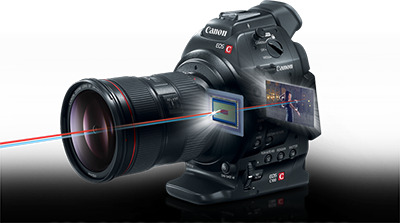
http://www.bhphotovideo.com/bnh/controller/home?O=NavBar&A=getItemDetail&Q=&sku=889545&is=REG&si=rev#costumerReview
Pretty cool, but has its drawbacks. Read the top best & worst reviews. The worst one sums up the issues well. Pretty cool though. I just continue to have the feeling (hope?) that somebody is going to come out with a mashup of the FS700 and this thing, or something like I thought the new EX camera would be - a combo of the usability and functionality of the EX cameras, but with the big sensor and slo-mo of the FS700. I'm guessing/hoping within a year...

http://www.bhphotovideo.com/bnh/controller/home?O=NavBar&A=getItemDetail&Q=&sku=889545&is=REG&si=rev#costumerReview
Pretty cool, but has its drawbacks. Read the top best & worst reviews. The worst one sums up the issues well. Pretty cool though. I just continue to have the feeling (hope?) that somebody is going to come out with a mashup of the FS700 and this thing, or something like I thought the new EX camera would be - a combo of the usability and functionality of the EX cameras, but with the big sensor and slo-mo of the FS700. I'm guessing/hoping within a year...
Sony PMW 300
June/24/13 12:31
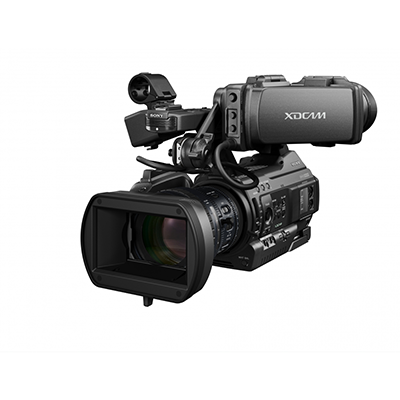
I have a feeling that the new Sony PMW-300:
1) It should be a good solid camera that may have a useful lifespan
2) It's too little too late in some ways
The improvements over the existing EX cameras are incremental. I had frankly hoped for some sort of merging of the EX's with the Fs700 or something along those lines, but I guess the EX-type camera is stuck being a half-inch, three-sensor deal. I've been meaning to do some research on the tradeoffs between 3 chip and the big single chip cameras.
It certainly is nice to have 4:2:2 onboard recording, since regular XDCAM EX is getting long in the tooth, but it's not a huge difference, and I would still use it as simultaneous-record backup. Once you go direct to ProRes, it's pretty hard to go back unless you have to. But for those shooting handheld, and those shooting for Euro broadcast, it certainly makes sense.
The big question mark in my mind is, what will the implementation of the future XAVC codec upgrade be? They are using that codec now in the F5 and F55. Since it already will have 422 50Mbps recording, I'm assuming it will be the 444/ up to 300Mbps flavor. That will likely require buying all new high speed cards to handle the data rate. Plus the rest of the workflow that goes with it - which admittedly is less onerous than much of the 4k & RAW crap that's going on at the moment.
Speaking of which, I've been reading a lot the press and blogs about 4k and RAW, and I really don't see the need for either for a vast majority of shooters - unless you have a client who wants to pay for it, or you want it for your own project. You pay a big price in terms of data rate, cards, hard drives, editing, money, etc. for differences most people can't see. The compressed codecs are just too good for the most part. Hell, I'm still shooting all 720p60, and my clients think it looks awesome. Depends on what you're used to.
The other thing I wonder about XAVC is, being another implementation of H.264, what is its future once H.265 hits the real world? The codec (aka HEVC - high efficiency video codec) has been officially released, and so it should just be a matter of time before it is implemented in cameras and such. H.264 is 10 years old now. H.265 is half the data rate for the same quality (allegedly).
Still cameras for video
January/30/13 12:34
My thought is still to use a video camera for video. Too many hassles and compromises with using still cameras for video.
It's cool if you are a still photographer who has a lot invested in lenses and you want to get into video, but if you're starting from scratch, the extra stuff you need will end up driving the cost up to the level of a dedicated video camera, and then it's not an integrated system.
This is the big problem with this whole trend toward what I might call 'mini-Cine' rigs - there's a lot of stuff and expense aside from the camera head itself. Which is why for most of us, a PMW-type camera is ideal. I mean, unless you really have a NEED for the interchangeable lenses that you get paid for (and will mostly be working cine-style).
It's cool if you are a still photographer who has a lot invested in lenses and you want to get into video, but if you're starting from scratch, the extra stuff you need will end up driving the cost up to the level of a dedicated video camera, and then it's not an integrated system.
This is the big problem with this whole trend toward what I might call 'mini-Cine' rigs - there's a lot of stuff and expense aside from the camera head itself. Which is why for most of us, a PMW-type camera is ideal. I mean, unless you really have a NEED for the interchangeable lenses that you get paid for (and will mostly be working cine-style).
Sony PMW 200
September/01/12 12:44
Some pros and cons on the new Sony camera
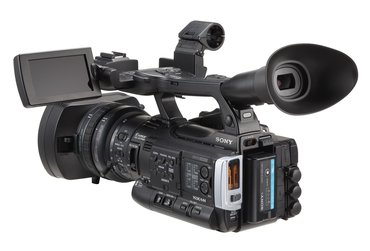
$7,800 list price. The EX-1 listed for around that but sold for $6,500. I think the earlier numbers were guesstimates of the street price.
Yeah - not exactly cheap. B&H is listing it for $6,300. Plus cards and batts and etc. But it's the same price as the EX-1 was back when I bought it, so not terrible. And you don't have to buy a lens, and can likely get by without an external recorder.
The only thing that's a bit of a bummer (for me, if I was to consider it as a replacement for my EX-1) is that it is essentially the same chips and lens as the EX-1 with some added features and better on-board recording. So it's not like I would be getting better quality from the main guts of the thing. Yes, the recordings going to the cards would be better, but with the Samurai, I am already getting 4:2:2 AND even higher-bitrate ProRes, so I can technically make better recordings with my existing camera.
If I didn't already own the EX-1, though, I would definitely put it high on the consideration list.
The integration with 'pro' XDCAM stuff will be big for a lot of folks. It should make it easier to do dailies and archives to BD, which I would really like. I'm finding myself wishing I had an easy way to burn discs of the raw footage I shoot on the thing. I have already lost some original footage by mistakenly erasing the wrong hard drive (the one with the ONLY backup on it - AFTER I had re-used the cards).
So just having it on hard drives still makes me nervous, even if I have two copies. After a year or so, you start looking back through the HDs and going, "hey there's a bunch of space on this one, what if I moved this over here, blah blah…" and pretty soon you don't know what you've got or where it is. Clearly I need better data management skills. If it's burned to a shiny disc though, it's locked down for at least a decade - it's more like having a tape master backup. I think a lot of pro environments are still using DLT tape, but unless that has changed significantly, it takes forever. I guess you just leave it running overnight.

$7,800 list price. The EX-1 listed for around that but sold for $6,500. I think the earlier numbers were guesstimates of the street price.
Yeah - not exactly cheap. B&H is listing it for $6,300. Plus cards and batts and etc. But it's the same price as the EX-1 was back when I bought it, so not terrible. And you don't have to buy a lens, and can likely get by without an external recorder.
The only thing that's a bit of a bummer (for me, if I was to consider it as a replacement for my EX-1) is that it is essentially the same chips and lens as the EX-1 with some added features and better on-board recording. So it's not like I would be getting better quality from the main guts of the thing. Yes, the recordings going to the cards would be better, but with the Samurai, I am already getting 4:2:2 AND even higher-bitrate ProRes, so I can technically make better recordings with my existing camera.
If I didn't already own the EX-1, though, I would definitely put it high on the consideration list.
The integration with 'pro' XDCAM stuff will be big for a lot of folks. It should make it easier to do dailies and archives to BD, which I would really like. I'm finding myself wishing I had an easy way to burn discs of the raw footage I shoot on the thing. I have already lost some original footage by mistakenly erasing the wrong hard drive (the one with the ONLY backup on it - AFTER I had re-used the cards).
So just having it on hard drives still makes me nervous, even if I have two copies. After a year or so, you start looking back through the HDs and going, "hey there's a bunch of space on this one, what if I moved this over here, blah blah…" and pretty soon you don't know what you've got or where it is. Clearly I need better data management skills. If it's burned to a shiny disc though, it's locked down for at least a decade - it's more like having a tape master backup. I think a lot of pro environments are still using DLT tape, but unless that has changed significantly, it takes forever. I guess you just leave it running overnight.
Sony FS100
August/31/12 12:46
This is some interesting footage.
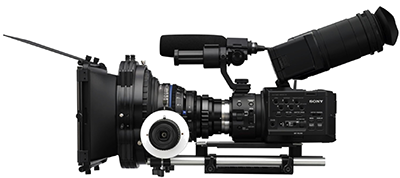
http://nofilmschool.com/2012/08/sony-fs100-vs-blackmagic-cinema-camera-low-light-showdown/?utm_source=feedburner&utm_medium=feed&utm_campaign=Feed%3A+nofilmschool+%28NoFilmSchool%29
Unfortunately, it reminds me somewhat of the first Zacuto Shootout, where they set up a really difficult-to-image scene so you could see where the cameras/codecs broke. It doesn't tell you a whole lot more than that. In this situation, they both look pretty bad - except that you can see that RAW has a lot more latitude than the other codecs (no surprise there).
Based on this and other footage I've seen from the FS100, I would want to record to an external recorder. I still haven't seen anything really great from it even though it has a big sensor. But it seems like people are always posting torture tests or bad grades, and we're supposed to figure out what the cameras can do from that? That was what was so interesting about the recent Shootout, where they let people who work with the various cameras every day do what is necessary to make it look good. And they pretty much ALL looked good.
So it seems to me the biggest factors when buying a camera now are: What's it REALLY going to cost you to do the workflow the camera sets you up for, and does the camera have the functionality you need for working with it all day to do the type of shooting you do?
I would not want to give up all the standard, pro-camera type controls you get on a unit from one of the major manufacturers for the promise of potentially better images. Functionality is a big deal. As an example, a (former Oprah) guy that works for me on occasion, who does a lot of run-n-gun is bummed that all these cool cameras coming out are not standard broadcast-shoulder-mount style cameras. He just can't see having to put together some sort of rig just to be able to use it on his shoulder - and then he probably couldn't one-hand it!
Most of the new cameras are intended for cinema-style shooting. They are large-sensors to compete with DSLRs. That's why it's nice to see stuff like the PMW-200. Though it's not like the Sonys of the world have stopped making old-school cameras. It's that the technology in the new cameras is not immediately showing up in a familiar form.

http://nofilmschool.com/2012/08/sony-fs100-vs-blackmagic-cinema-camera-low-light-showdown/?utm_source=feedburner&utm_medium=feed&utm_campaign=Feed%3A+nofilmschool+%28NoFilmSchool%29
Unfortunately, it reminds me somewhat of the first Zacuto Shootout, where they set up a really difficult-to-image scene so you could see where the cameras/codecs broke. It doesn't tell you a whole lot more than that. In this situation, they both look pretty bad - except that you can see that RAW has a lot more latitude than the other codecs (no surprise there).
Based on this and other footage I've seen from the FS100, I would want to record to an external recorder. I still haven't seen anything really great from it even though it has a big sensor. But it seems like people are always posting torture tests or bad grades, and we're supposed to figure out what the cameras can do from that? That was what was so interesting about the recent Shootout, where they let people who work with the various cameras every day do what is necessary to make it look good. And they pretty much ALL looked good.
So it seems to me the biggest factors when buying a camera now are: What's it REALLY going to cost you to do the workflow the camera sets you up for, and does the camera have the functionality you need for working with it all day to do the type of shooting you do?
I would not want to give up all the standard, pro-camera type controls you get on a unit from one of the major manufacturers for the promise of potentially better images. Functionality is a big deal. As an example, a (former Oprah) guy that works for me on occasion, who does a lot of run-n-gun is bummed that all these cool cameras coming out are not standard broadcast-shoulder-mount style cameras. He just can't see having to put together some sort of rig just to be able to use it on his shoulder - and then he probably couldn't one-hand it!
Most of the new cameras are intended for cinema-style shooting. They are large-sensors to compete with DSLRs. That's why it's nice to see stuff like the PMW-200. Though it's not like the Sonys of the world have stopped making old-school cameras. It's that the technology in the new cameras is not immediately showing up in a familiar form.
Blackmagic Cinema Camera & Resolve
August/23/12 12:47
You can download some footage from the Camera, and grade it with free Resolve
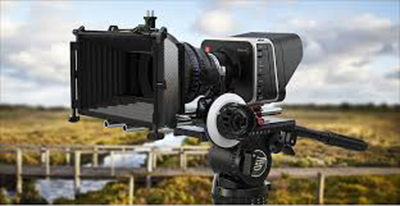
I looked at the stuff and downloaded one of the clips into (my free copy of) Resolve*. The file has a lot of latitude, which is good. It sort of affirmed my initial feeling about the camera, though. It is definitely a high-value unit considering all you get with it - BUT:
• it has a small sensor compared to most stuff these days - it has a cheaper look than some. Though, that needs to be taken with a grain of salt given the results of the Shootout. Depends what you do with it.
• the lens used in these shots costs $4k (plus matte box, plus, etc.)
• to really take advantage of much of the unit's capabilities, you would need MANY thousands of dollars worth of hardware and software - unless you already own it. One of the big things with DSLR-video popularity is that still photographers with thousands invested in lenses, but who would never spend thousands on a video camera, could now be 'HD videographers' by upgrading their still camera body, which they would do anyway.
* If you want to find out for free how complex and how much of a potential pain in the ass REAL color grading is, download Resolve and set it up. If you get that far, grade some stuff in it (if you import from FCP, etc. - make sure you have no effects on your clips and all the clips are in one video track).
It is a massively powerful program, exciting and awesome, no doubt about it. But for most practical purposes, it's too much work (takes too much time, as did Color). Also really works best with a bunch of high-end computer and controller hardware.

- Blackmagic and John Brawley Release RAW Cinema Camera Files for Download
I looked at the stuff and downloaded one of the clips into (my free copy of) Resolve*. The file has a lot of latitude, which is good. It sort of affirmed my initial feeling about the camera, though. It is definitely a high-value unit considering all you get with it - BUT:
• it has a small sensor compared to most stuff these days - it has a cheaper look than some. Though, that needs to be taken with a grain of salt given the results of the Shootout. Depends what you do with it.
• the lens used in these shots costs $4k (plus matte box, plus, etc.)
• to really take advantage of much of the unit's capabilities, you would need MANY thousands of dollars worth of hardware and software - unless you already own it. One of the big things with DSLR-video popularity is that still photographers with thousands invested in lenses, but who would never spend thousands on a video camera, could now be 'HD videographers' by upgrading their still camera body, which they would do anyway.
* If you want to find out for free how complex and how much of a potential pain in the ass REAL color grading is, download Resolve and set it up. If you get that far, grade some stuff in it (if you import from FCP, etc. - make sure you have no effects on your clips and all the clips are in one video track).
It is a massively powerful program, exciting and awesome, no doubt about it. But for most practical purposes, it's too much work (takes too much time, as did Color). Also really works best with a bunch of high-end computer and controller hardware.
Zacuto Shootout Revenge 2012 and Baselight
August/12/12 12:49
Really proves that it's not about the gear - it’s what you do with it.
http://www.zacuto.com/shootout-revenge-2012
Been wondering when they would finish this one. What a stunner, eh?! It's not the meat, it's the motion - so to speak : )
Seems like the big deal is shooting something that looks good in reality - if you start there, you're halfway home - almost any camera can image it - and the capability of grading now is amazing. Though to be fair, you would have to have another shootout between the full Baselight system they used and other grading alternatives. Baselight recently came out with a plugin for FCP7. (!) I was very excited about that idea until I started to realize that I could live without FCP7.
I watched the Part 1 camera comparisons twice, and had very different notes the second time around. After seeing the "answers" it became clear that the major deal was, "did the DP light it in a way you like, and did the camera guys shoot it well for that camera, and THEN did they make choices in post that you like". I thought it was telling that Sony took total control of the F65 footage, yet it wasn't in everybody's top group.
Baselight is a major grading program and the full systems with all the control hardware are very expensive. But they recently came out with a plugin for FCP7 - I think it's around $1,000 (a fraction of their former cheapest product). Software only, and it works from WITHIN FCP like any other plugin. So this was very exciting to a lot of folks to have the capability of Baselight integrated into FCP. But they didn't come out with it until after FCPX arrived, so they seemed behind the times.
http://www.filmlight.ltd.uk/baselightfcp.php
I would only recommend it if you had a real need for doing extensive grading. I used Apple Color a few times and it was a pain in that you have to export from FCP to it (without effects), grade, then re-import and render. Clunky. Baselight would have the advantage of working inside FCP. But you can do everything most projects need with FCP's color correctors and/or additional plugins.
FCPX's color correction takes some getting used to (though FAR easier than learning Baselight or Color) and is very powerful - great keyer, easy inside/outside color and shape mattes, etc. I think what FCPX is working toward is a single integrated program that does everything most people need in one piece of software - as opposed to the former model of having a bunch of separate programs that more or less "talk" to each other.
The second program of the Shootout shows some of the stuff people chose to do in post. Sony sent their own team to shoot with the F65, and they did all of the post themselves, unlike the rest of the group. I think they were the ONLY ones who did not alter or add to the lgihting setup, though.
I think generally you could say that the higher end cameras and their teams went for looks that showed the fact that the cameras handle a broader range of color and contrast (the lighting range was 14 stops) and as a result look generally somewhat less contrasty and saturated than the others. Most people are probably attracted to a more contrasty and saturated look - one that "pops", as long as it can still give you some nice skin tones and color rendition.
One of the problems with trying to guess which is which was the fact that they allowed additional lighting and grading - so, for example, while you might assume a "lesser" camera would be unable to show both detail in the woman on the right standing in shadow as well as having the window not blown out - many made adjustments to the window in post.
One of the shockers was how many chose the $800 Panasonic GH2 still camera. It was one of my choices, too, though I'm not sure how much it had to do with being the second one shown. The first one, the F3, seemed soft looking in comparison, which caused me to guess that the GH2 was a higher resolution camera. I thought it might be the Alexa on the first viewing - it seemed to have LOTS of "information" in the image.
I think peoples' guesses and likes would be changed by the order they were shown in. My top three ended up being the Panasonic, the 7D and the F65 (after watching them through twice). I could not tell for sure which was the iPhone, though there are telltale signs. I was surprised that the F3 wasn't in my top 3, but again, if you did the same lighting and post stuff to it as the ones you liked, I'm sure it would look fabulous.
http://www.zacuto.com/shootout-revenge-2012
Been wondering when they would finish this one. What a stunner, eh?! It's not the meat, it's the motion - so to speak : )
Seems like the big deal is shooting something that looks good in reality - if you start there, you're halfway home - almost any camera can image it - and the capability of grading now is amazing. Though to be fair, you would have to have another shootout between the full Baselight system they used and other grading alternatives. Baselight recently came out with a plugin for FCP7. (!) I was very excited about that idea until I started to realize that I could live without FCP7.
I watched the Part 1 camera comparisons twice, and had very different notes the second time around. After seeing the "answers" it became clear that the major deal was, "did the DP light it in a way you like, and did the camera guys shoot it well for that camera, and THEN did they make choices in post that you like". I thought it was telling that Sony took total control of the F65 footage, yet it wasn't in everybody's top group.
Baselight is a major grading program and the full systems with all the control hardware are very expensive. But they recently came out with a plugin for FCP7 - I think it's around $1,000 (a fraction of their former cheapest product). Software only, and it works from WITHIN FCP like any other plugin. So this was very exciting to a lot of folks to have the capability of Baselight integrated into FCP. But they didn't come out with it until after FCPX arrived, so they seemed behind the times.
http://www.filmlight.ltd.uk/baselightfcp.php
I would only recommend it if you had a real need for doing extensive grading. I used Apple Color a few times and it was a pain in that you have to export from FCP to it (without effects), grade, then re-import and render. Clunky. Baselight would have the advantage of working inside FCP. But you can do everything most projects need with FCP's color correctors and/or additional plugins.
FCPX's color correction takes some getting used to (though FAR easier than learning Baselight or Color) and is very powerful - great keyer, easy inside/outside color and shape mattes, etc. I think what FCPX is working toward is a single integrated program that does everything most people need in one piece of software - as opposed to the former model of having a bunch of separate programs that more or less "talk" to each other.
The second program of the Shootout shows some of the stuff people chose to do in post. Sony sent their own team to shoot with the F65, and they did all of the post themselves, unlike the rest of the group. I think they were the ONLY ones who did not alter or add to the lgihting setup, though.
I think generally you could say that the higher end cameras and their teams went for looks that showed the fact that the cameras handle a broader range of color and contrast (the lighting range was 14 stops) and as a result look generally somewhat less contrasty and saturated than the others. Most people are probably attracted to a more contrasty and saturated look - one that "pops", as long as it can still give you some nice skin tones and color rendition.
One of the problems with trying to guess which is which was the fact that they allowed additional lighting and grading - so, for example, while you might assume a "lesser" camera would be unable to show both detail in the woman on the right standing in shadow as well as having the window not blown out - many made adjustments to the window in post.
One of the shockers was how many chose the $800 Panasonic GH2 still camera. It was one of my choices, too, though I'm not sure how much it had to do with being the second one shown. The first one, the F3, seemed soft looking in comparison, which caused me to guess that the GH2 was a higher resolution camera. I thought it might be the Alexa on the first viewing - it seemed to have LOTS of "information" in the image.
I think peoples' guesses and likes would be changed by the order they were shown in. My top three ended up being the Panasonic, the 7D and the F65 (after watching them through twice). I could not tell for sure which was the iPhone, though there are telltale signs. I was surprised that the F3 wasn't in my top 3, but again, if you did the same lighting and post stuff to it as the ones you liked, I'm sure it would look fabulous.
The new Sony PMW 200
June/20/12 12:50
It’s pretty bitchin’

People have been complaining that they aren't putting pro codecs in these awesome cameras they're coming out with - like the FS100 and 700. Why a so-so AVCHD onboard codec, and not an established pro codec like XDCAM? Even the EX1 and EX3 are XDCAM EX 4:2:0 at 35 Mbps. This little unit is XDCAM 4:2:2 at 50 Mbps! Cool!
Again, though, I would like to see what this (new, I think) sensor looks like. Assuming it doesn't suck, the camera looks like a sure-thing-type good investment. TC in/out, Genlock in/out, SDI out…. it will likely get a lot of use in multi cam shoots due to the connectivity alone.
The big question is, "Where is the PMW-EX5?". Many expect that to be the next thing to drop.

People have been complaining that they aren't putting pro codecs in these awesome cameras they're coming out with - like the FS100 and 700. Why a so-so AVCHD onboard codec, and not an established pro codec like XDCAM? Even the EX1 and EX3 are XDCAM EX 4:2:0 at 35 Mbps. This little unit is XDCAM 4:2:2 at 50 Mbps! Cool!
Again, though, I would like to see what this (new, I think) sensor looks like. Assuming it doesn't suck, the camera looks like a sure-thing-type good investment. TC in/out, Genlock in/out, SDI out…. it will likely get a lot of use in multi cam shoots due to the connectivity alone.
The big question is, "Where is the PMW-EX5?". Many expect that to be the next thing to drop.
Sony PMW 100
June/19/12 12:52
It's a spiff unit - but a pretty small chip.
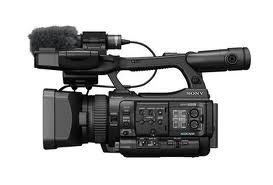
Might be a good replacement for the Panasonic AX-100 - level stuff. Would like to go HD with all clients, but not for free!
One thing to pay attention to on these new cameras is that some are 3-chip and some are 1. Traditionally that was how you could tell a pro camera from a consumer. Like the EX1 is (3) 1/2" chips. Stuff like the Sony FS100/700/F3, etc. are competing with large DSLRs, so they are 1 LARGE chip. The PMW 100 is (1) slightly-larger-than ⅓” chip (1/2.9"), so I dunno how that will perform. Certainly they're making great strides in that area. And the onboard 50Mbps XDCAM recording capability is cool - wouldn't necessarily need an outboard recorder. It'll be interesting to see some footage from it.

Might be a good replacement for the Panasonic AX-100 - level stuff. Would like to go HD with all clients, but not for free!
One thing to pay attention to on these new cameras is that some are 3-chip and some are 1. Traditionally that was how you could tell a pro camera from a consumer. Like the EX1 is (3) 1/2" chips. Stuff like the Sony FS100/700/F3, etc. are competing with large DSLRs, so they are 1 LARGE chip. The PMW 100 is (1) slightly-larger-than ⅓” chip (1/2.9"), so I dunno how that will perform. Certainly they're making great strides in that area. And the onboard 50Mbps XDCAM recording capability is cool - wouldn't necessarily need an outboard recorder. It'll be interesting to see some footage from it.
Sony vs. Blackmagic
June/12/12 12:54
I mis-wrote when I said the BMCC is future-4k -- it's the Sony FS-700 that will have that capability. The BM is a 2.5k sensor.
Phillip Bloom reviews the Sony:
http://www.creativeplanetnetwork.com/dv/news/philip-bloom-reviews-sony-fs700/59608
Well really kinda apples and oranges here, they're both nice but different. One thing that seems to get lost in the Blackmagic deal is that despite being a (future) 4k-capable imager, the chip is WAY smaller than the Sony. BOTH need lenses and other expensive add-ons. On the plus side of the BM vs. Sony is the built-in SSD recorder, includes Resolve AND Ultrascopes (each worth about a grand) though you pretty much need a Thunderbolt-capable computer to go with it. I would say the Sony is a more "traditional" camera (in a good way) from the functionality point of view. Plus it does awesome slo-mo. I would guess that it will generally make better images than the BM, due to the imager - but in order to be apple-to-apples there, the Sony requires an outboard recorder like the Atomos Samurai, etc.
What I mean by that is that the BM has an onboard hard drive recorder that can potentially record in any format - and on the high end natively records 12 bit RAW files. The Sony's internal recorder is NXCAM AVCHD compressed files. As with my EX1, which records XDCAM EX at 35mbps - you have to go out the SDI spigot to get a 4:2:2 uncompressed signal, and to record that properly you need an external recorder. The Samurai records ProRes in three flavors, I typically use the middle ProRes422 at 150mbps.
So if you wanted to truly compare the outputs of the BM and 700 apples-to-apples, you would need to record the Sony to a high res external recorder. (Or set the BM to record compressed) So - another point for the BM. $3k INCLUDING internal RAW recording capability AND full Resolve AND Ultra Scopes. That would be a deal at $5 or $6K. The Sony is $8k without lens (or external recorder, or Resolve or scopes).
This is not to say that the Sony's internal AVCHD files would not be fine for most stuff. A drive in my Samurai locked up on a recent shoot, and so all I had was the XDCAM on the cards in the camera as backup. Bummed me out, but the clients can't tell. And I sure was glad I had the backup rather than having to re-shoot a half day.
So it's a lot to sort out. I'm having this issue with a lot of items these days - not just what do they do, but what don't they do - and what's the best for my particular needs?
BMCC
April/16/12 12:55
Some initial thoughts on The Black Magic Cinema Camera:

This thing is going to sell like hotcakes. If you already own primes, it's sort of a no-brainer (assuming it delivers). For me, I think I still want a camera with an integrated/controllable zoom. Interchangeable lenses, yes; but I want to have the body and lens talk to each other. A lot of these cameras coming out lately (including the Sony F3, until the recent zoom for it came out) are in this we-do-the-imager and you-do-the-lenses...and the-camera-may-not-talk-to-the-lens deal. Which can be fine if you really are mostly shooting "cine style". For corporate, I gotta have a zoom that works with it. Be interested to see if Sony says anything about a zoom for the FS700.
This is the way stuff has been going in the big-sensor, DSLR-killer market -- toward separate cameras and lenses, intended for "film-style" shooting. Which usually means you're going to hang a bunch of expensive crap on it to make it do what a full-on pro camcorder does. That was one of the things that was popular about the Sony EX3, that you could use better lenses. I was glad the lens they put on the EX1 was as good as it is. It's really a decent all-rounder, especially if you can work around its limitations.
That footage from the BMCC makes me wonder if it will have the ability to set picture profiles as on Sonys. That footage had a pretty soft, ungraded look - although he was apparently trying to see mostly the dynamic range of the thing. DaVinci Resolve will work with either legacy FCP or X - you export XML from FCP and correct in Resolve, then come back. They just made that possible in FCPX - it was one of the things it couldn't do before. You have to have (I believe) a Blackmagic thunderbolt-capable box to make FCPX and Resolve work together.
That's a VERY attractive aspect of the Blackmagic Camera - that it comes with Resolve AND the Scopes. You'll probably need a Blackmagic thunderbolt box as well. It's a very Jobs-like deal - they are making an awesome piece of elegant hardware that will drive sales of their other products. (I'm 3/4 the way through the Steve Jobs bio - it's an amazing story). An integrated bunch of hardware and software all by the same company (well - except for the NLE).

This thing is going to sell like hotcakes. If you already own primes, it's sort of a no-brainer (assuming it delivers). For me, I think I still want a camera with an integrated/controllable zoom. Interchangeable lenses, yes; but I want to have the body and lens talk to each other. A lot of these cameras coming out lately (including the Sony F3, until the recent zoom for it came out) are in this we-do-the-imager and you-do-the-lenses...and the-camera-may-not-talk-to-the-lens deal. Which can be fine if you really are mostly shooting "cine style". For corporate, I gotta have a zoom that works with it. Be interested to see if Sony says anything about a zoom for the FS700.
This is the way stuff has been going in the big-sensor, DSLR-killer market -- toward separate cameras and lenses, intended for "film-style" shooting. Which usually means you're going to hang a bunch of expensive crap on it to make it do what a full-on pro camcorder does. That was one of the things that was popular about the Sony EX3, that you could use better lenses. I was glad the lens they put on the EX1 was as good as it is. It's really a decent all-rounder, especially if you can work around its limitations.
That footage from the BMCC makes me wonder if it will have the ability to set picture profiles as on Sonys. That footage had a pretty soft, ungraded look - although he was apparently trying to see mostly the dynamic range of the thing. DaVinci Resolve will work with either legacy FCP or X - you export XML from FCP and correct in Resolve, then come back. They just made that possible in FCPX - it was one of the things it couldn't do before. You have to have (I believe) a Blackmagic thunderbolt-capable box to make FCPX and Resolve work together.
That's a VERY attractive aspect of the Blackmagic Camera - that it comes with Resolve AND the Scopes. You'll probably need a Blackmagic thunderbolt box as well. It's a very Jobs-like deal - they are making an awesome piece of elegant hardware that will drive sales of their other products. (I'm 3/4 the way through the Steve Jobs bio - it's an amazing story). An integrated bunch of hardware and software all by the same company (well - except for the NLE).
Sony large sensor cams
April/06/12 12:56
The Large Sensor Camera that I have pixel envy for currently is the Sony F3:

http://pro.sony.com/bbsc/ssr/show-highend/resource.solutions.bbsccms-assets-show-highend-pmwf3.shtml
They have a much cheaper version (NEX-FS 100U) that is really popular due to having the 35mm-ish-size sensor, but it is hobbled in a few ways from a video pro's perspective:
http://pro.sony.com/bbsc/ssr/micro-nxcamsite/resource.latest.bbsccms-assets-micro-nxcam-solutions-nexfs100ulanding
But they've just announced, pre-NAB the updated version which looks very cool (addresses a lot of the issues, plus does super slo-mo and will do full 4k with a future upgrade) the 700U:
http://www.engadget.com/2012/04/02/sony-nex-fs700-cinema-camera/
So the F3 costs too much but is awesome, the 100U is way cheaper but not something I would really want to own, but I'll be really interested to see exactly what and how much the 700 turns out to be - supposed to be under $10k, but I'm not sure if that's with or without lens.
I was kind of hoping for a little brother of the F3 rather than a big brother of the FS100, but I imagine they're selling a lot more 100's and they're cheaper to produce. I still think there should be a PMW-EX5 or something that updates the EX1 and 3 to a large sensor. But that's probably not possible in that camera's architecture - again, not sure, just wishful thinking. This 700 could mostly be it. Plus the path to 4k inspires confidence in its future viability.
I broke down and pimped my EX1 with a matte box, rails and focus knob from Shoot35. Nice bang for the buck vs. the major players. So now there's a place to mount the Samurai and 7" monitor.

http://pro.sony.com/bbsc/ssr/show-highend/resource.solutions.bbsccms-assets-show-highend-pmwf3.shtml
They have a much cheaper version (NEX-FS 100U) that is really popular due to having the 35mm-ish-size sensor, but it is hobbled in a few ways from a video pro's perspective:
http://pro.sony.com/bbsc/ssr/micro-nxcamsite/resource.latest.bbsccms-assets-micro-nxcam-solutions-nexfs100ulanding
But they've just announced, pre-NAB the updated version which looks very cool (addresses a lot of the issues, plus does super slo-mo and will do full 4k with a future upgrade) the 700U:
http://www.engadget.com/2012/04/02/sony-nex-fs700-cinema-camera/
So the F3 costs too much but is awesome, the 100U is way cheaper but not something I would really want to own, but I'll be really interested to see exactly what and how much the 700 turns out to be - supposed to be under $10k, but I'm not sure if that's with or without lens.
I was kind of hoping for a little brother of the F3 rather than a big brother of the FS100, but I imagine they're selling a lot more 100's and they're cheaper to produce. I still think there should be a PMW-EX5 or something that updates the EX1 and 3 to a large sensor. But that's probably not possible in that camera's architecture - again, not sure, just wishful thinking. This 700 could mostly be it. Plus the path to 4k inspires confidence in its future viability.
I broke down and pimped my EX1 with a matte box, rails and focus knob from Shoot35. Nice bang for the buck vs. the major players. So now there's a place to mount the Samurai and 7" monitor.
